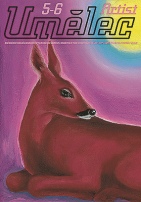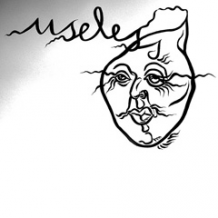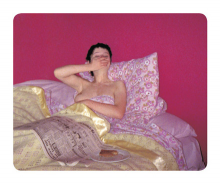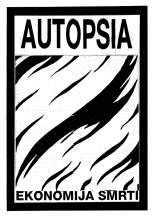| Revista Umělec 1999/5-6 >> American Glamorama | Lista de todas las ediciones | ||||||||||||
|
|||||||||||||
American GlamoramaRevista Umělec 1999/5-601.05.1999 Františka a Tim Gilman-Ševčík | new york | en cs |
|||||||||||||
|
"The long, cold shadow of Draconian mayor Rudolph Giuliani crept over New York City and changed the mean streets forever. In the five years that the city has squirmed under his fist, crime has practically disappeared, along with all of the criminals; homelessness has almost disappeared, along with the homeless. The independent coffee shops and diners that pepper the city streets are being squeezed off every block by Wendy’s, McDonalds’, Starbucks, and all the other breeds of corporate animal that pop up like welts under Giuliani’s lash. For every panhandler missing from the corner there are now two cops, cornfed steroid monsters who have been known to put 44 bullets into your black body if you so much as wave a newspaper at them.
Admittedly, it is pleasant to walk safe streets, but the city seems a little drained of color as it cultivates its new Disney image, beckoning tourists to flood the sidewalks. The new shining jewel in the mayor’s dark crown is the recently re-opened and thoroughly scrubbed Grand Central Station. The murky alcoves where scores of homeless once bedded down on cardboard pallets have been reborn as chandelier-lit public art spaces sheathed in impeccable marble from the spotless floors to the arching ceilings. Liza Lou was aptly chosen as the first artist to grace these new halls. She works with the miniscule on a monumental scale, applying Czech glass beads, sequins and other shiny baubles to quintessential emblems of the American consciousness. The centerpiece of her exhibition, entitled “American Glamorama“ is “Backyard,“ a sprawling, life-size diorama of a barbecue picnic, frozen in mid-action, but devoid of human participants. A lawnmower has halted only a few feet onto the lawn, leaving a small path of grass chopped short behind it. A million unruly, uncut blades of grass are forever spared from its destructive cleanup. Every blade of grass is a precise and variegated string of beads, and the mind melts thinking of the time spent in creating each of the multitude individually. Every object, the lawnmower, the open barbecue, the picnic table covered in a red and white checked cloth, the crushed cans of Budweiser that litter it, and the washing line with laundry that blows in the wind glitters with an iridescent skin of beads. “Utility Closet,“ set into a nearby wall, houses the jumbled shelves of tools and board games that every average American household hides. Lou pushes them into the spotlight, making the invisible over-visible, lavishing attention on things you could easily forget you own. None of the objects she adorns are treasures, but when the gilt is applied to their familiar utilitarian surface, they gain a sheen that boasts of preciousness. This skin of glamour works like Hollywood magic which twists people and places into marketable dreams. Grand Central’s refurbished chandeliers hang like obese cousins to Lou’s smaller, beaded version that lights a portrait gallery depicting all of the U.S. presidents. From Washington to Clinton, the 42 smiling faces are made of thousands of white sequins, and the cherubic similarity of their Anglo features make them hard to distinguish from one another. Our noble forefathers are flanked by three gargantuan Barbie Dolls which stand almost two meters high; a black bride, a blond businesswoman and a black sixties’ stereotyped “soul mama,“ inadvertently suggesting the marriage of American politics, pop culture and commerce. The black bride sparkles in an overdone rhinestone dress. A pawn in the typical American transformation of ritual into extravagant excess, her blissful face expects the transcendent effect of an event hollowed of historical meaning. She could just as easily be a child in front of a mountain of presents on Christmas morning. Her “soul sister,“ the other black Barbie with the three-foot Afro and cutoff jean shorts is a throwback to the idealized past of Black Power, when the country stood on the verge of a revolution that never came. The 42 white presidents stand as reaffirming evidence of that fact. The proud, blond working girl is also living in a euphoric dream at the time of the women’s liberation movement that promised her equal footing with men. She may have her hopes up, but she is still a Barbie, and she has a very short skirt. The work is seemingly celebratory of the subjects, which are elevated through the construction of a deceptive surface. Beads, sequins and other sparkles painstakingly clothe, obscure and „improve“ what lies beneath. But beads have an ignoble history in America, and though it is not alluded to in the work, it’s hard to forget that beads and liquor served as currency to buy the country away from Native Americans. They are a material ingredient in a grand illusion, and Liza Lou is a Las Vegas architect. This is perfectly devious public art, it awes the public with the way it shines and brings smiles while it subtly cuts at the very threads of the society that so happily supports it. "
01.05.1999
Artículos recomendados
|
|||||||||||||
|
04.02.2020 10:17
Letošní 50. ročník Art Basel přilákal celkem 93 000 návštěvníků a sběratelů z 80 zemí světa. 290 prémiových galerií představilo umělecká díla od počátku 20. století až po současnost. Hlavní sektor přehlídky, tradičně v prvním patře výstavního prostoru, představil 232 předních galerií z celého světa nabízející umění nejvyšší kvality. Veletrh ukázal vzestupný trend prodeje prostřednictvím galerií jak soukromým sbírkám, tak i institucím. Kromě hlavního veletrhu stály za návštěvu i ty přidružené: Volta, Liste a Photo Basel, k tomu doprovodné programy a výstavy v místních institucích, které kvalitou daleko přesahují hranice města tj. Kunsthalle Basel, Kunstmuseum, Tinguely muzeum nebo Fondation Beyeler.
|




































 We Are Rising National Gallery For You! Go to Kyjov by Krásná Lípa no.37.
We Are Rising National Gallery For You! Go to Kyjov by Krásná Lípa no.37.
Comentarios
Actualmente no hay comentariosAgregar nuevo comentario